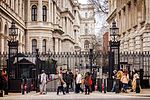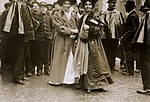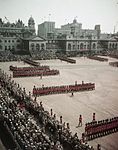Statue of the Earl Kitchener, London
1926 establishments in the United Kingdom1926 sculpturesBronze sculptures in the United KingdomCultural depictions of Herbert Kitchener, 1st Earl KitchenerGrade II listed monuments and memorials ... and 9 more
Grade II listed statues in the City of WestminsterLondon stubsMilitary memorials in LondonOutdoor sculptures in LondonSculptures of men in the United KingdomStatues of military officersStatues of politiciansUnited Kingdom sculpture stubsWhitehall

The statue of the Earl Kitchener is an outdoor bronze statue by John Tweed depicting Herbert Kitchener, 1st Earl Kitchener, installed in 1926 and located on the south side of Horse Guards Parade in London, United Kingdom. The sculpture stands on a Portland stone plinth. It contains the following inscription: KITCHENER/ 1850–1916/ ERECTED BY PARLIAMENT.The statue was cast by A. B. Burton at his Thames Ditton Foundry.
Excerpt from the Wikipedia article Statue of the Earl Kitchener, London (License: CC BY-SA 3.0, Authors, Images).Statue of the Earl Kitchener, London
Treasury Passage, City of Westminster Covent Garden
Geographical coordinates (GPS) Address Nearby Places Show on map
Geographical coordinates (GPS)
| Latitude | Longitude |
|---|---|
| N 51.5039 ° | E -0.128 ° |
Address
Horse Guards Parade (Horseguards Parade)
Treasury Passage
SW1A 2AS City of Westminster, Covent Garden
England, United Kingdom
Open on Google Maps











